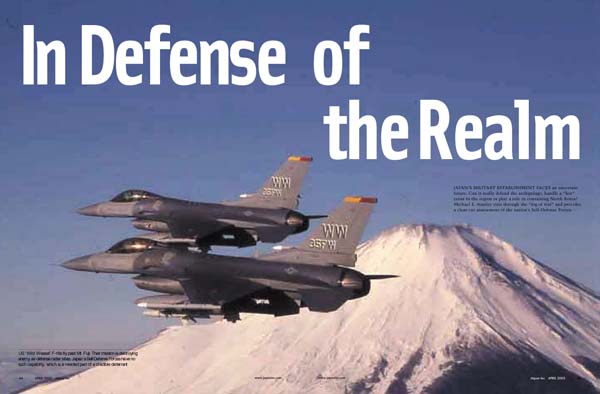
JAPAN'S MILITARY ESTABLISHMENT FACES an uncertain future. Can it really defend the archipelago, handle a "hot" crisis in the region or play a role in containing North Korea? Michael E. Stanley cuts through the "fog of war" and provides a clear-cut assessment of the nation's Self-Defense Forces.
Winston Churchill once opined that every nation must have an army -- either its own or someone else's. Japan has apparently opted for both. While relying on the superpower-level forces of the United States, and hosting a significant portion of those US forces stationed in the Pacific region, Japan has developed its own land, sea and air forces as well. Despite the limitations of its "peace" Constitution, the three Self-Defense Forces are obviously far more than the result of a mere token effort. These forces have in recent years grown markedly in ability and professionalism, but the question hangs in the air: to what end? Changes in the region's stability during the last decade and a half have now thrust an evidently unwilling Japan into the treacherous geopolitical currents of northeast Asia. Recent events have highlighted Japan's vulnerability to missile attack and air or sea incursion. The common concept that the country is a "rear area" is largely a wishful fiction. Tokyo is 10 minutes -- or less -- flight time for a North Korea-launched Nodong missile.
Tokyo is 10 minutes -- or less -- flight time for a
North Korea-launched Nodong missile
There are questions and doubts about Japan's military capabilities -- and about whether those capabilities are in fact limited to self-defense. In addition, the presence and capabilities of the US military forces based in Japan are not solely driven by or limited to providing a shield for Japan. The US units in the archipelago mesh tightly with those in South Korea; together, they are a well-planned, integrated and flexible force dedicated to maintaining a clearly capable forward military presence in the region. This is a far cry from the types and disposition of US forces in the region just prior to the opening of the Korean War in June 1950. Without the current presence, the resulting power vacuum would eventually be filled by Japan or one of its neighbors. Those neighbors who had the unfortunate experience of occupation by Japanese forces during World War II tend to be quite sensitive to any change, real or imagined, in Japan's capabilities, and the suggestion of a fully armed Japan results in a predictably negative reaction. For them, the US military presence in Japan is often seen as a cork in the bottle; the US being here obviates any need for Japan to arm itself. Far too often, however, it seems that the shrill and formulaic reactions of neighboring nations are knee-jerk rituals out of sync with current reality.
While Japan has some of the finest military systems and equipment in the world, such as the F-15 fighter, the shipboard AEGIS antiaircraft/antimissile system and Patriot air-defense missiles, the Self-Defense Forces have insufficient depth even to accomplish a complete defense of their own nation. To do so against an all-out attack would require the assistance of the US -- as spelled out in the Joint Security Treaty -- in no small measure. Even at twice their current strength, the Self-Defense Forces would be utterly incapable of carrying out any kind of serious offensive campaign.
Advancing forces and AWACS
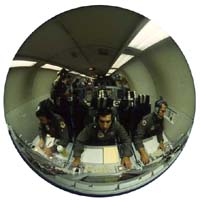
I have been observing the Japan-US defense relationship at very close range for almost two decades. For the majority of that time, I have focused on the relationship between the two nations' air forces. I have seen the process of change at work as the Cold War drew to its surprising end and the structure of power in northeast Asia moved into a new and precarious pattern. In addition, the IT revolution began to make its effects felt in what military specialists term the RMA -- the revolution in military affairs. Great changes have begun as this ever-accelerating course of IT developments has started to clear many aspects of what 19th-century military philosopher Carl von Clausewitz termed the "fog of war." Failure to integrate this ongoing information and communication revolution into both long- and short-range planning will spell disaster should a truly "hot" crisis arise. As recent developments on the Korean peninsula have hinted, that possibility could be close at hand.
The capabilities that will be critical to Japan's Self-Defense Forces in the coming decades will not be deeply dependent on new developments in blockbuster munitions or longer-range missiles. Put concisely, the major challenges will deal with information technology and communications across a whole panoply of applications, logistics, technical support and capabilities for what is called MOOTW: military operations other than war. Included in this list is the need to gain public understanding that the Self-Defense Forces must expand their capabilities in these areas. To see how Japan has been responding to these challenges, a look at a system that came into operational use in recent years will provide a useful example.
Japan's AWACS may well play a significant supporting role
should hostilities erupt on the Korean peninsula
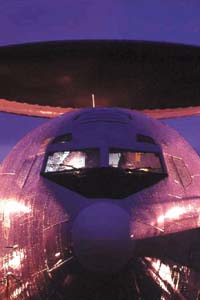 In the mid-1990s, the Japan Air Self-Defense Force (JASDF) began standard training operations with Boeing-built Airborne Warning and Control Systems aircraft -- better known as AWACS. The system is essentially a flying radar facility; its altitude and mobility give it great advantages over ground-based radars. AWACS can see farther over the horizon than can ground-based radar; that ability provides a decisive information edge. Inside the AWACS are independent but linked radar consoles from which the actions of fighters and other aircraft can be controlled and directed. For example, the AWACS controllers can see incoming hostile aircraft and marshal interceptors to the most advantageous position to engage them. The controllers essentially provide a "God's-eye-view" of the aerial battlespace. In bilateral defense-of-Japan exercises such as Cope North and Keen Sword, US controllers in both ground and AWACS facilities routinely provide control for JASDF aircraft and vice versa. Since the AWACS radar can peer well over the horizon, it can look into an adversary's own airspace and provide the key to mounting a successful aerial attack. This was done by the US and its coalition allies to great effect in the 1990-91 Gulf War and was a signal factor in the destruction of Iraq's air force before it could do any serious damage to the coalition forces. The more left-leaning elements in Japan's press seized on this capability; to them, the JASDF's AWACS aircraft would be used as spy planes for use in aggressive warfare. Emphasis on this aspect tended to obscure the fact that the sprawling length and breadth of Japan's airspace is a major factor in the defensibility of the nation, and that the acquisition of the AWACS system brought Japan up to par in the task of being prepared to defend it. The Japanese public on the whole had almost no understanding whatsoever of what the system's acquisition could mean for Japan's defense; they essentially left the matter in the hands of the bureaucrats and politicians.
In the mid-1990s, the Japan Air Self-Defense Force (JASDF) began standard training operations with Boeing-built Airborne Warning and Control Systems aircraft -- better known as AWACS. The system is essentially a flying radar facility; its altitude and mobility give it great advantages over ground-based radars. AWACS can see farther over the horizon than can ground-based radar; that ability provides a decisive information edge. Inside the AWACS are independent but linked radar consoles from which the actions of fighters and other aircraft can be controlled and directed. For example, the AWACS controllers can see incoming hostile aircraft and marshal interceptors to the most advantageous position to engage them. The controllers essentially provide a "God's-eye-view" of the aerial battlespace. In bilateral defense-of-Japan exercises such as Cope North and Keen Sword, US controllers in both ground and AWACS facilities routinely provide control for JASDF aircraft and vice versa. Since the AWACS radar can peer well over the horizon, it can look into an adversary's own airspace and provide the key to mounting a successful aerial attack. This was done by the US and its coalition allies to great effect in the 1990-91 Gulf War and was a signal factor in the destruction of Iraq's air force before it could do any serious damage to the coalition forces. The more left-leaning elements in Japan's press seized on this capability; to them, the JASDF's AWACS aircraft would be used as spy planes for use in aggressive warfare. Emphasis on this aspect tended to obscure the fact that the sprawling length and breadth of Japan's airspace is a major factor in the defensibility of the nation, and that the acquisition of the AWACS system brought Japan up to par in the task of being prepared to defend it. The Japanese public on the whole had almost no understanding whatsoever of what the system's acquisition could mean for Japan's defense; they essentially left the matter in the hands of the bureaucrats and politicians.
The AWACS system is now an integrated, indispensable element of Japan's own defense, and it complements the three US Air Force AWACS aircraft stationed at Kadena Air Base, Okinawa. Japan's AWACS may well play a significant supporting role should hostilities erupt on the Korean peninsula.
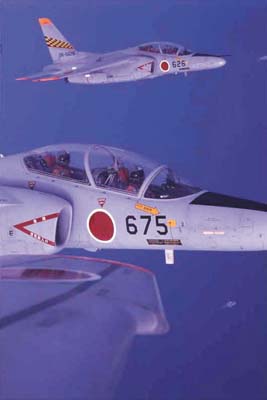 Until the deployment of Japanese Ground Self-Defense Force personnel to various peacekeeping missions in such places as Cambodia, Mozambique, Zaire (now the Democratic Republic of the Congo) and Israel's Golan Heights -- a development of the 1990s -- Japanese forces had no need for long-range air transport capability. Their C-130s (a 4-engine turboprop) and C-1s (a two-engine jet of indigenous design) were sufficient for the task of moving personnel around the islands of Japan. However, with the advent of these distant deployments, the difficulty of supporting them with the "short legs" of the JASDF transports became evident. It is realistic to expect that Japan will continue to dispatch its troops for such UN-sponsored efforts around the world; it is also realistic to expect that at some point in the not-too-distant future, Japan will look into acquiring longer legs either by buying (or building under license) transport aircraft such as the US-made C-17, or by trying to develop and build a new, larger transport on its own. Acquisition of such an aircraft type will not only help deploy Self-Defense Forces personnel farther and faster, but will allow for larger-scale Japanese participation in international crisis-response operations.
Until the deployment of Japanese Ground Self-Defense Force personnel to various peacekeeping missions in such places as Cambodia, Mozambique, Zaire (now the Democratic Republic of the Congo) and Israel's Golan Heights -- a development of the 1990s -- Japanese forces had no need for long-range air transport capability. Their C-130s (a 4-engine turboprop) and C-1s (a two-engine jet of indigenous design) were sufficient for the task of moving personnel around the islands of Japan. However, with the advent of these distant deployments, the difficulty of supporting them with the "short legs" of the JASDF transports became evident. It is realistic to expect that Japan will continue to dispatch its troops for such UN-sponsored efforts around the world; it is also realistic to expect that at some point in the not-too-distant future, Japan will look into acquiring longer legs either by buying (or building under license) transport aircraft such as the US-made C-17, or by trying to develop and build a new, larger transport on its own. Acquisition of such an aircraft type will not only help deploy Self-Defense Forces personnel farther and faster, but will allow for larger-scale Japanese participation in international crisis-response operations.
For the first time, JASDF fighters will engage in air-to-air
refueling from US Air Force tanker aircraft
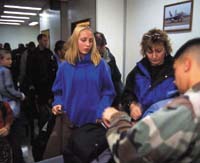 While the Japanese aircraft industry has not yet tackled the design and construction of a large transport, the possibility that it might do so is not out of character. Each of Japan's military aircraft projects since the end of the Pacific War has been a step in keeping the nation's industry reasonably current with the worldwide state of the art. From the T-1 trainer (Japan's first jet), the F-1 fighter (the nation's first combat aircraft) and the C-1 (its first jet transport) on through to the license-built F-4EJ and F-15J fighters and to the current domestically developed T-4 jet trainer and F-2 fighter (largely based on licensed technology from the US-made F-16), each step has been a calculated move to acquire skills and technology and to "keep current" in aerospace development.
While the Japanese aircraft industry has not yet tackled the design and construction of a large transport, the possibility that it might do so is not out of character. Each of Japan's military aircraft projects since the end of the Pacific War has been a step in keeping the nation's industry reasonably current with the worldwide state of the art. From the T-1 trainer (Japan's first jet), the F-1 fighter (the nation's first combat aircraft) and the C-1 (its first jet transport) on through to the license-built F-4EJ and F-15J fighters and to the current domestically developed T-4 jet trainer and F-2 fighter (largely based on licensed technology from the US-made F-16), each step has been a calculated move to acquire skills and technology and to "keep current" in aerospace development.
Japan even has a special niche of its own when it comes to military technology: The Japan Maritime Self-Defense Force (JMSDF) operates the US-1, a four-engine turboprop flying boat designed and manufactured by ShinMaywa Industries. The JMSDF is the only naval or air arm to still use such aircraft. A decade ago, their value was proven in the rescue of a US Air Force fighter pilot who had suffered a midair collision during a transpacific deployment. He ejected safely but parachuted into the winter seas about 1,000 kilometers east of Tokyo. No US asset could have possibly reached him in time to effect a rescue; a JMSDF US-1 set down on the heaving sea and plucked him from what would otherwise have been an unsurvivable situation.
According to its own laws, Japan cannot export military aircraft, but the time just may come when civilian variants of transports or trainers make their appearance overseas. This seems almost unthinkable now, but Japanese participation in overseas peacekeeping operations was equally unthinkable a little more than a decade ago.
JASDF and the USAF
In June 1999, the Japan Air Self-Defense Force sent a detachment of F-15s to participate in a Guam-based Cope North bilateral exercise with the US Air Force. That was the first time Japanese combat aircraft had landed outside Japanese airspace since the end of World War II. The event passed almost unnoticed by the Japanese media. There were two main motives behind this first overseas deployment (and those that have followed since): One was to give JASDF units the challenge and experience of working outside their own bases and their own way of doing things, something they may well face in a future coalition effort. The other was to allow for more realistic, full-on training than is possible in the cramped air-combat training areas over Japan. This kind of exercise experience is about to be stepped up by an order of magnitude.
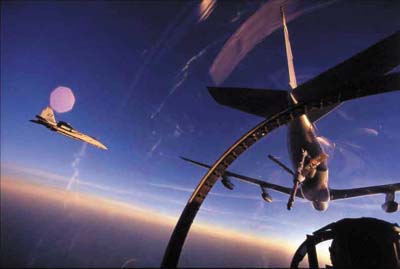 Just before this issue of J@pan Inchits the stands, the JASDF will be participating in a Cope North exercise within Japan, but with a very special twist. For the first time, JASDF fighters will engage in air-to-air refueling from US Air Force tanker aircraft, an operation that has become a part of the USAF's daily routine over the last half century. This ability will give Japan's fighters greater range and stamina, factors important in mounting an effective air defense over the archipelago's airspace. However, the flipside of this ability is increased range, an aspect sure to cause some heartburn among Japan's neighbors, not least North Korea.
Just before this issue of J@pan Inchits the stands, the JASDF will be participating in a Cope North exercise within Japan, but with a very special twist. For the first time, JASDF fighters will engage in air-to-air refueling from US Air Force tanker aircraft, an operation that has become a part of the USAF's daily routine over the last half century. This ability will give Japan's fighters greater range and stamina, factors important in mounting an effective air defense over the archipelago's airspace. However, the flipside of this ability is increased range, an aspect sure to cause some heartburn among Japan's neighbors, not least North Korea.
Contrary to the claims of Japan's Space Agency,
its current generation of launch vehicles would be rather easily
adaptable to accurately hefting nuclear warheads
In mid-February, Defense Agency director-general Shigeru Ishiba flatly stated that if Japan were to detect North Korea fueling its ballistic missiles, then it might exercise the option to attack them as an act of self-defense. These brave words had little to back them; the missile sites are at the far edge of the effective range of JASDF aircraft. There would be little or no fuel leeway. Those fighters defending North Korean airspace could mount a fairly effective defense just by engaging the attack aircraft so as to cause high fuel consumption. (Of course, one option that Japan has used in a highly visible role before is a one-way mission.)
These limitations evaporate, however, if JASDF aircraft can refuel in the air. A jet-powered combat aircraft usually consumes up to one-third of its fuel load just getting off the ground. A common pattern for US planes is an air-to-air refueling soon after takeoff, more refueling mid-flight, if necessary, and an additional refueling on the way home.
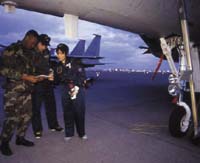 Japan's F-15 fighters have been built with the air-refueling piping in place but covered by the skin of the aircraft. Now the fuel inlet doors have been installed and the fighters can refuel. On the new F-2 attack fighter, which is a Japanese-built variation on the F-16 and is just coming on line, the refueling hardware has been in place since the initial design stages. After this spring's Cope North, JASDF fighters will participate in a Cope Thunder exercise in Alaska. For the first time, combat aircraft bearing the Rising Sun insignia will fly outside the Asian region. Cope Thunder is a huge air-combat, realistic exercise that is, in the words of one US pilot: "The closest you can get to war without bullets." In order to reach Alaska and make it back to Japan, the participating JASDF F-15s will have to refuel on the way to and from this excursion. The refueling tankers in these cases will be US aircraft, but a budget has been allotted for the first JASDF tanker aircraft, built on the Boeing 767 airframe, and they will likely be in operation in three to four years. From that time, Japan's combat aircraft will surely play a larger role, for example, in a multinational crisis response in the region. Japan's flying tankers will also be able to support US aircraft just as Japan Maritime Self-Defense Force supply vessels have supported naval efforts in the Indian Ocean.
Japan's F-15 fighters have been built with the air-refueling piping in place but covered by the skin of the aircraft. Now the fuel inlet doors have been installed and the fighters can refuel. On the new F-2 attack fighter, which is a Japanese-built variation on the F-16 and is just coming on line, the refueling hardware has been in place since the initial design stages. After this spring's Cope North, JASDF fighters will participate in a Cope Thunder exercise in Alaska. For the first time, combat aircraft bearing the Rising Sun insignia will fly outside the Asian region. Cope Thunder is a huge air-combat, realistic exercise that is, in the words of one US pilot: "The closest you can get to war without bullets." In order to reach Alaska and make it back to Japan, the participating JASDF F-15s will have to refuel on the way to and from this excursion. The refueling tankers in these cases will be US aircraft, but a budget has been allotted for the first JASDF tanker aircraft, built on the Boeing 767 airframe, and they will likely be in operation in three to four years. From that time, Japan's combat aircraft will surely play a larger role, for example, in a multinational crisis response in the region. Japan's flying tankers will also be able to support US aircraft just as Japan Maritime Self-Defense Force supply vessels have supported naval efforts in the Indian Ocean.
Thinking the unthinkable
It is more than a little apparent that the changes taking place in Japan's defense capability have been in the planning for quite a while. There is one additional aspect that has recently been brought to the fore, chiefly by pundits who have a minimal understanding of what is involved: the hitherto "unthinkable" possibility that Japan may opt to arm itself with nuclear weapons. It is fairly obvious that if Japan should choose to do so, the technical challenges would prove to be no real hurdle. Plutonium is at hand, and a base for ballistic missile technology is in place. Contrary to the claims of Japan's Space Agency, its current generation of launch vehicles would be rather easily adaptable to the task of accurately hefting nuclear warheads. It is highly likely that if the order was given, within the space of a year -- and possibly a much shorter span -- Japan could mount its own initial nuclear deterrent. It is time for Japan's leaders to engage more openly with their own people and with the world. Three and four decades ago, when Japan's military was a weak little benchwarmer, this was not a pressing concern. Now it is. @
Michael E. Stanley is a freelance photographer and writer based in Chiba and a frequent contributor to J@pan Inc.
|




 In the mid-1990s, the Japan Air Self-Defense Force (JASDF) began standard training operations with Boeing-built Airborne Warning and Control Systems aircraft -- better known as AWACS. The system is essentially a flying radar facility; its altitude and mobility give it great advantages over ground-based radars. AWACS can see farther over the horizon than can ground-based radar; that ability provides a decisive information edge. Inside the AWACS are independent but linked radar consoles from which the actions of fighters and other aircraft can be controlled and directed. For example, the AWACS controllers can see incoming hostile aircraft and marshal interceptors to the most advantageous position to engage them. The controllers essentially provide a "God's-eye-view" of the aerial battlespace. In bilateral defense-of-Japan exercises such as Cope North and Keen Sword, US controllers in both ground and AWACS facilities routinely provide control for JASDF aircraft and vice versa. Since the AWACS radar can peer well over the horizon, it can look into an adversary's own airspace and provide the key to mounting a successful aerial attack. This was done by the US and its coalition allies to great effect in the 1990-91 Gulf War and was a signal factor in the destruction of Iraq's air force before it could do any serious damage to the coalition forces. The more left-leaning elements in Japan's press seized on this capability; to them, the JASDF's AWACS aircraft would be used as spy planes for use in aggressive warfare. Emphasis on this aspect tended to obscure the fact that the sprawling length and breadth of Japan's airspace is a major factor in the defensibility of the nation, and that the acquisition of the AWACS system brought Japan up to par in the task of being prepared to defend it. The Japanese public on the whole had almost no understanding whatsoever of what the system's acquisition could mean for Japan's defense; they essentially left the matter in the hands of the bureaucrats and politicians.
In the mid-1990s, the Japan Air Self-Defense Force (JASDF) began standard training operations with Boeing-built Airborne Warning and Control Systems aircraft -- better known as AWACS. The system is essentially a flying radar facility; its altitude and mobility give it great advantages over ground-based radars. AWACS can see farther over the horizon than can ground-based radar; that ability provides a decisive information edge. Inside the AWACS are independent but linked radar consoles from which the actions of fighters and other aircraft can be controlled and directed. For example, the AWACS controllers can see incoming hostile aircraft and marshal interceptors to the most advantageous position to engage them. The controllers essentially provide a "God's-eye-view" of the aerial battlespace. In bilateral defense-of-Japan exercises such as Cope North and Keen Sword, US controllers in both ground and AWACS facilities routinely provide control for JASDF aircraft and vice versa. Since the AWACS radar can peer well over the horizon, it can look into an adversary's own airspace and provide the key to mounting a successful aerial attack. This was done by the US and its coalition allies to great effect in the 1990-91 Gulf War and was a signal factor in the destruction of Iraq's air force before it could do any serious damage to the coalition forces. The more left-leaning elements in Japan's press seized on this capability; to them, the JASDF's AWACS aircraft would be used as spy planes for use in aggressive warfare. Emphasis on this aspect tended to obscure the fact that the sprawling length and breadth of Japan's airspace is a major factor in the defensibility of the nation, and that the acquisition of the AWACS system brought Japan up to par in the task of being prepared to defend it. The Japanese public on the whole had almost no understanding whatsoever of what the system's acquisition could mean for Japan's defense; they essentially left the matter in the hands of the bureaucrats and politicians.
 Until the deployment of Japanese Ground Self-Defense Force personnel to various peacekeeping missions in such places as Cambodia, Mozambique, Zaire (now the Democratic Republic of the Congo) and Israel's Golan Heights -- a development of the 1990s -- Japanese forces had no need for long-range air transport capability. Their C-130s (a 4-engine turboprop) and C-1s (a two-engine jet of indigenous design) were sufficient for the task of moving personnel around the islands of Japan. However, with the advent of these distant deployments, the difficulty of supporting them with the "short legs" of the JASDF transports became evident. It is realistic to expect that Japan will continue to dispatch its troops for such UN-sponsored efforts around the world; it is also realistic to expect that at some point in the not-too-distant future, Japan will look into acquiring longer legs either by buying (or building under license) transport aircraft such as the US-made C-17, or by trying to develop and build a new, larger transport on its own. Acquisition of such an aircraft type will not only help deploy Self-Defense Forces personnel farther and faster, but will allow for larger-scale Japanese participation in international crisis-response operations.
Until the deployment of Japanese Ground Self-Defense Force personnel to various peacekeeping missions in such places as Cambodia, Mozambique, Zaire (now the Democratic Republic of the Congo) and Israel's Golan Heights -- a development of the 1990s -- Japanese forces had no need for long-range air transport capability. Their C-130s (a 4-engine turboprop) and C-1s (a two-engine jet of indigenous design) were sufficient for the task of moving personnel around the islands of Japan. However, with the advent of these distant deployments, the difficulty of supporting them with the "short legs" of the JASDF transports became evident. It is realistic to expect that Japan will continue to dispatch its troops for such UN-sponsored efforts around the world; it is also realistic to expect that at some point in the not-too-distant future, Japan will look into acquiring longer legs either by buying (or building under license) transport aircraft such as the US-made C-17, or by trying to develop and build a new, larger transport on its own. Acquisition of such an aircraft type will not only help deploy Self-Defense Forces personnel farther and faster, but will allow for larger-scale Japanese participation in international crisis-response operations.
 While the Japanese aircraft industry has not yet tackled the design and construction of a large transport, the possibility that it might do so is not out of character. Each of Japan's military aircraft projects since the end of the Pacific War has been a step in keeping the nation's industry reasonably current with the worldwide state of the art. From the T-1 trainer (Japan's first jet), the F-1 fighter (the nation's first combat aircraft) and the C-1 (its first jet transport) on through to the license-built F-4EJ and F-15J fighters and to the current domestically developed T-4 jet trainer and F-2 fighter (largely based on licensed technology from the US-made F-16), each step has been a calculated move to acquire skills and technology and to "keep current" in aerospace development.
While the Japanese aircraft industry has not yet tackled the design and construction of a large transport, the possibility that it might do so is not out of character. Each of Japan's military aircraft projects since the end of the Pacific War has been a step in keeping the nation's industry reasonably current with the worldwide state of the art. From the T-1 trainer (Japan's first jet), the F-1 fighter (the nation's first combat aircraft) and the C-1 (its first jet transport) on through to the license-built F-4EJ and F-15J fighters and to the current domestically developed T-4 jet trainer and F-2 fighter (largely based on licensed technology from the US-made F-16), each step has been a calculated move to acquire skills and technology and to "keep current" in aerospace development.
 Just before this issue of J@pan Inchits the stands, the JASDF will be participating in a Cope North exercise within Japan, but with a very special twist. For the first time, JASDF fighters will engage in air-to-air refueling from US Air Force tanker aircraft, an operation that has become a part of the USAF's daily routine over the last half century. This ability will give Japan's fighters greater range and stamina, factors important in mounting an effective air defense over the archipelago's airspace. However, the flipside of this ability is increased range, an aspect sure to cause some heartburn among Japan's neighbors, not least North Korea.
Just before this issue of J@pan Inchits the stands, the JASDF will be participating in a Cope North exercise within Japan, but with a very special twist. For the first time, JASDF fighters will engage in air-to-air refueling from US Air Force tanker aircraft, an operation that has become a part of the USAF's daily routine over the last half century. This ability will give Japan's fighters greater range and stamina, factors important in mounting an effective air defense over the archipelago's airspace. However, the flipside of this ability is increased range, an aspect sure to cause some heartburn among Japan's neighbors, not least North Korea.
 Japan's F-15 fighters have been built with the air-refueling piping in place but covered by the skin of the aircraft. Now the fuel inlet doors have been installed and the fighters can refuel. On the new F-2 attack fighter, which is a Japanese-built variation on the F-16 and is just coming on line, the refueling hardware has been in place since the initial design stages. After this spring's Cope North, JASDF fighters will participate in a Cope Thunder exercise in Alaska. For the first time, combat aircraft bearing the Rising Sun insignia will fly outside the Asian region. Cope Thunder is a huge air-combat, realistic exercise that is, in the words of one US pilot: "The closest you can get to war without bullets." In order to reach Alaska and make it back to Japan, the participating JASDF F-15s will have to refuel on the way to and from this excursion. The refueling tankers in these cases will be US aircraft, but a budget has been allotted for the first JASDF tanker aircraft, built on the Boeing 767 airframe, and they will likely be in operation in three to four years. From that time, Japan's combat aircraft will surely play a larger role, for example, in a multinational crisis response in the region. Japan's flying tankers will also be able to support US aircraft just as Japan Maritime Self-Defense Force supply vessels have supported naval efforts in the Indian Ocean.
Japan's F-15 fighters have been built with the air-refueling piping in place but covered by the skin of the aircraft. Now the fuel inlet doors have been installed and the fighters can refuel. On the new F-2 attack fighter, which is a Japanese-built variation on the F-16 and is just coming on line, the refueling hardware has been in place since the initial design stages. After this spring's Cope North, JASDF fighters will participate in a Cope Thunder exercise in Alaska. For the first time, combat aircraft bearing the Rising Sun insignia will fly outside the Asian region. Cope Thunder is a huge air-combat, realistic exercise that is, in the words of one US pilot: "The closest you can get to war without bullets." In order to reach Alaska and make it back to Japan, the participating JASDF F-15s will have to refuel on the way to and from this excursion. The refueling tankers in these cases will be US aircraft, but a budget has been allotted for the first JASDF tanker aircraft, built on the Boeing 767 airframe, and they will likely be in operation in three to four years. From that time, Japan's combat aircraft will surely play a larger role, for example, in a multinational crisis response in the region. Japan's flying tankers will also be able to support US aircraft just as Japan Maritime Self-Defense Force supply vessels have supported naval efforts in the Indian Ocean.



